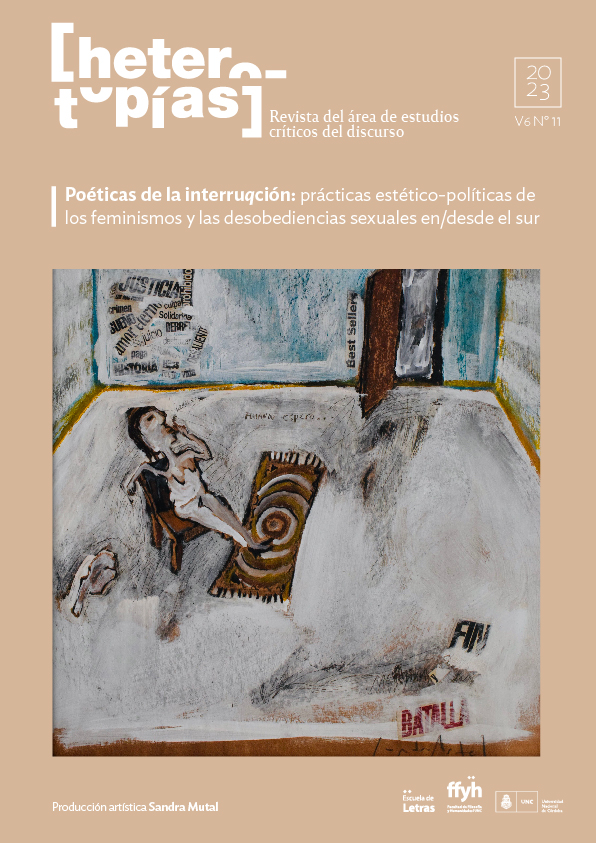Los feminismos no se toman cuarentena. Intervenciones callejeras feministas rosarinas en pandemia
Contenido principal del artículo
Resumen
En este trabajo nos proponemos reflexionar acerca de las prácticas estético políticas feministas en el espacio público de Rosario durante la pandemia, con el foco puesto en la dimensión estética de la protesta social. La invención política callejera de los feminismos en los últimos años produjo una magnitud y diversidad de intervenciones y de colectivos inéditos. Sin embargo, el advenimiento de la pandemia trajo alteraciones a ese itinerario e implicó repensar la ocupación del espacio y la disposición de los cuerpos en un contexto de medidas de cuidado. A partir de la confección de una matriz en la que se registraron y sistematizaron un conjunto de intervenciones callejeras, se han utilizado herramientas metodológicas cualitativas para el análisis del herramental expresivo empleado por los distintos colectivos, de los formatos que adoptaron las acciones callejeras, y de la espacialidad de las intervenciones, es decir, las formas de apropiación del espacio público.
Downloads
Detalles del artículo
Sección

Esta obra está bajo una licencia internacional Creative Commons Atribución-NoComercial-CompartirIgual 4.0.
- Usted es libre de:
Compartir — copiar y redistribuir el material en cualquier medio o formato
Adaptar — remezclar, transformar y construir a partir del material
- Bajo los siguientes términos:
Atribución — Usted debe dar crédito de manera adecuada, brindar un enlace a la licencia, e indicar si se han realizado cambios. Puede hacerlo en cualquier forma razonable, pero no de forma tal que sugiera que usted o su uso tienen el apoyo de la licenciante.
NoComercial — Usted no puede hacer uso del material con propósitos comerciales.
CompartirIgual — Si remezcla, transforma o crea a partir del material, debe distribuir su contribución bajo la lamisma licencia del original.
Cómo citar
Referencias
Arbuet, Osuna C. y Gutiérrez, L. (2022). Disputar las nociones de cuidado en pandemia: intervenciones estético-políticas en Argentina, Brasil y Chile. L’Ordinaire des Amériques, 228. Recuperado de: http://journals.openedition.org/orda/7368
Bertolaccini, L. (2020). Plazas verdes. Estética y política en los activismos callejeros en torno a las demandas por aborto legal (Rosario, 2018). Artefacto visual, vol. 5, núm. 10, 65-91. Recuperado de: https://www.revlat.com/numero10
______ (2021). Desde el corazón de la marea. Estética y política en protestas sociales del movimiento feminista en Rosario. Rosario: UNR Editora.
Cabral, X. y Scribano, A. (2009). Política de las expresiones heterodoxas: el conflicto social en los escenarios de las crisis argentinas. Convergencia, 16, 51, 129-155.
Chávez Mac Gregor, H. (2009). Políticas de la aparición: estética y política. En Méndez Blake, J. (Comp.). La biblioteca muro. Vista del muro I (pp. 15-33).
______ (2015). Pese a todo, aparecer. Revista Re-visiones, 5, Instituto de Investigaciones Estéticas, Universidad Nacional Autónoma de México, México. Recuperado de: https://dialnet.unirioja.es/servlet/articulo?codigo=6829453
______ (2018). Ocupar el espacio. La batalla por la política. Recuperado de https://www.academia.edu/6335970/Ocupar_el_espacio.
Cuello, N. (2015). Flujos, roces y derrames del activismo artístico en Argentina (2003–2013): Políticas sexuales y comunidades de resistencia sexoafectiva. Errata,12, 70-95. Recuperado de: https://www.aacademica.org/nicolascuello/22
Di Filippo, M. (2015). Los movimientos sociales y sus prácticas estético- artísticas en el nuevo milenio. Un análisis del repertorio de protesta debido al asesinato de Pocho Lepratti en el 2001 argentino. En Valls, P. (Comp.) Fe de erratas: arte y política (pp. 48-63). Rosario: Ediciones Colaterales.
______ (2019). Estéticas políticas. Rosario: UNR Editora.
Expósito, M., Vindel, J., & Vidal, A. (2012). Activismo artístico. En Red Conceptualismos del Sur. Perder la forma humana. Una imagen sísmica de los años ochenta en América Latina (pp. 43-50). Madrid: Museo Nacional Centro de Arte Reina Sofía.
Giunta, A. (2009). Poscrisis. Arte argentino después de 2001. Buenos Aires: Siglo XXI.
______ (2019). Feminismo y arte latinoamericano: Historias de artistas que emanciparon el cuerpo. Buenos Aires: Siglo XXI.
Gutiérrez, L. (2018). Tortillear el paro. Imágenes y visibilidades lésbicas en el Primer Paro Internacional de Mujeres. En Actas del IX Jornadas Debates Actuales de la Teoría Política Contemporánea. Universidad Nacional de Rosario. Recuperado de: https://www.academia.edu/38458102/Tortillear_el_paro_Im%C3%A1genes_y_visibilidades_l%C3%A9sbicas_en_el_Primer_Paro_Internacional_pdf
______ (2021). Imágenes de lo posible Una genealogía discontinua de intervenciones lésbicas y feministas en Argentina (1986-2013). Córdoba: Asentamiento Fernseh.
Haber, M. (2020). Aproximación y diferimiento: resonancias afectivas en el cuerpo político feminista. Revista Diferencia(s), 10, 101-114. Recuperado de: http://www.revista.diferencias.com.ar/index.php/diferencias/article/view/212
Laudano, C, (2016). Feministas en ‘la red’. Reflexiones en torno a las potencialidades y restricciones de la participación en el ciberespacio. En Rovetto, F. y Fabbri, L.(Comps.) Sin feminismos no hay democracia: género y ciencias sociales. Rosario: Último recurso.
_______ (2019). Acerca del uso estratégico de TIC en movilizaciones feminista. En Rivoir, A. y Morales, M. (Coords.). Tecnologías digitales: Miradas críticas de la apropiación en América Latina (pp. 357-369). Buenos Aires: CLACSO.
Longoni, A. (2009). Activismo artístico en la última década en Argentina: algunas acciones en torno a la segunda desaparición de Jorge Julio López. Errata, 16-35. Recuperado de: https://revistaerrata.gov.co/edicion/errata0-el-lugar-del-arte-en-lo-politico
Longoni, A., y Bruzzone, G. A. (2008). El siluetazo. Buenos Aires: Adriana Hidalgo Editora.
López, M. D. (2017). Cambio de piel. Intervenciones culturales, acción colectiva y politicidad emergente en el espacio público de La Plata. Tesis de Doctorado. UNLP.
Pérez Balbi, M. (2020). Habitar/Confabular/Crear. Activismos artístico en La Plata. La Plata: EDULP.
Proaño Gómez, L. y Verzero, L. (Comps.) (2020). Mutis por el foro. Artes escénicas y política en tiempos de pandemia. Red de Estudios de Artes Escénicas Latinoamericanas y Editorial ASPO. Recuperado de https://www.academia.edu/44767637/Mutis_por_el_Foro.
Vázquez, C. (2019). Las multitudes feministas en el espacio público: estéticas, afectos y política. Ponencia presentada en el XXI° Congreso de la Red de Carreras de Comunicación Social y Periodismo, realizado en la Universidad Nacional de Salta.
